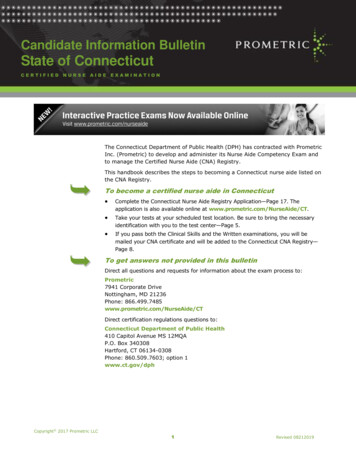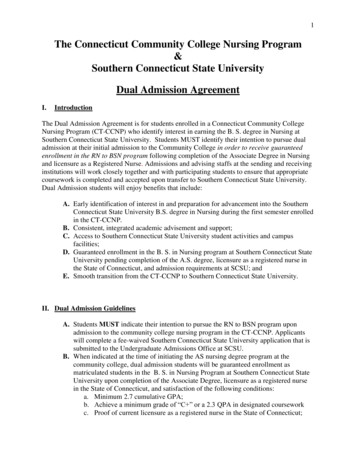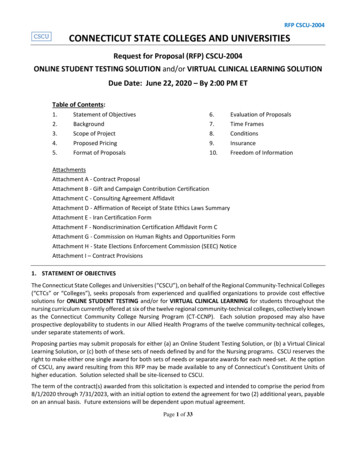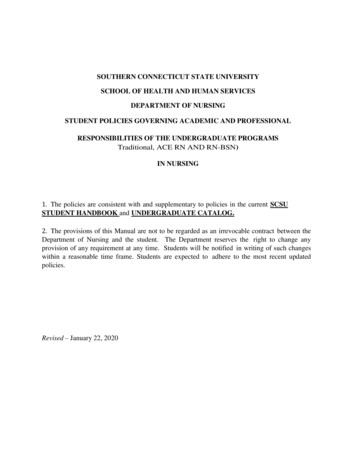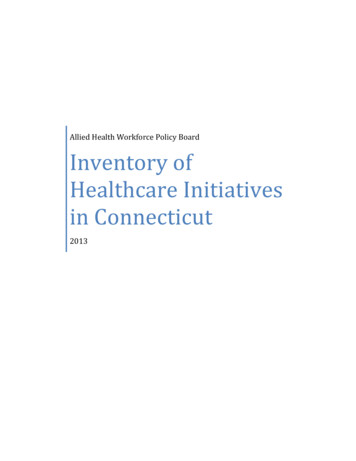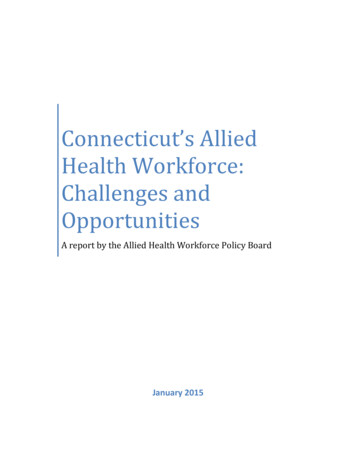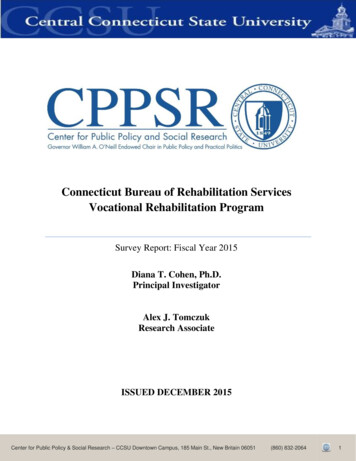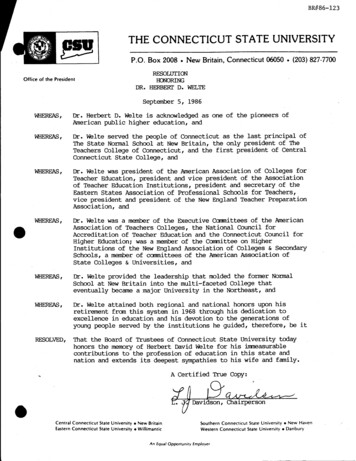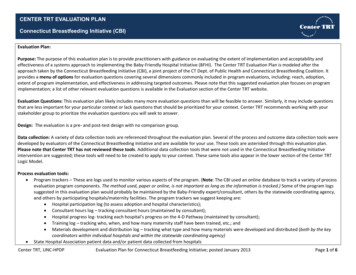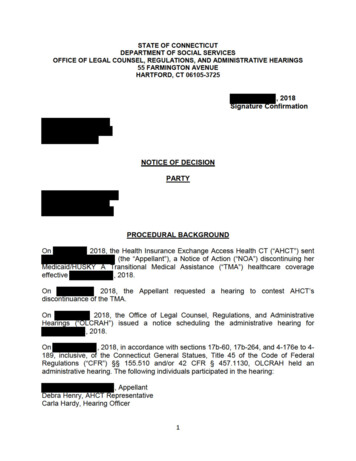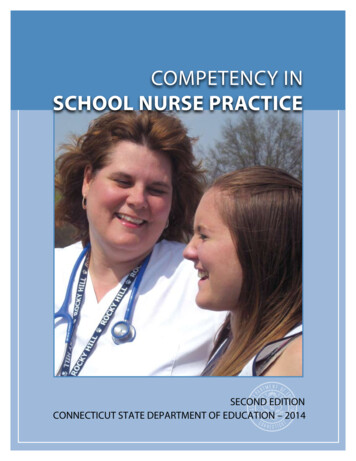
Transcription
competency inschool nurse practiceSECOND EDITIONconnecticut state department of education – 2014
Competency inSchool Nurse Practice(2nd Edition)Connecticut State Department of EducationJune 2014Page 1 of 23
Connecticut State Department of EducationStefan Pryor, Commissioner of EducationDivision of Family and Student Support ServicesCharlene Russell-Tucker, Chief Operating OfficerBureau of Health/Nutrition, Family Services and Adult EducationStephanie G. Knutson, School Health AdministratorEducation Consultant for School NursesOffice of Communications and Community PartnershipsMatthew J. Falconer, Editor and PublisherAndrea N. Wadowski, Graphic DesignerPage 2 of 23
The original document is available ontheConnecticut State Department of Education Web site at:www.ct.gov/sde/schoolnursePage 3 of 23
CONTENTSAcknowledgments .Preface .Introduction .Purpose .Highly Qualified Professionals .Competencies .Definition .Overview .Benner’s Application.How to Use the Competencies .School Nurse Competencies .Supervision .Overview .Supervision Requirements .Differences between administrative and clinical supervision .Models of supervision.Clinical supervision .Supervision by non-nursing personnel .Regional supervision.Peer/group supervision .Peer mentoring .Professional Development.Additional Roles of the Supervisor .Evaluation .Summary .References .Resources .AppendixA. School nurse self-evaluation competencies tool.B. Sample School nurse performance evaluation summary tool .C. Sample Comprehensive school nurse performance evaluation summary tool .Page 4 of 23
ACKNOWLEDGMENTSThis document was developed through the cooperation of numerous professionals committed toimproving the quality of school health services in Connecticut. The Connecticut State Department ofEducation (CSDE) extends its thanks to Cheryl Resha, Suzanne Levasseur and Vicki Taliaferro for thereview and development of the 2014 Revised Competency in School Nurse Practice and theaccompanying Evaluation Tools, in collaboration with Stephanie Knutson, CSDE’s School HealthAdministrator and Education Consultant for School Nurses.The CSDE would also like to extend appreciation to the following original task force members for theircollaboration, expertise and perseverance.Nancy Bafundo, Chair, Connecticut Board of Examiners for NursesJoAnn Bouldan, Nursing Supervisor, Madison Public SchoolsJoan Cagginello, Nursing Administrator, Milford Health DepartmentDonna Kosiorowski, School Nurse Supervisor, West Haven Public SchoolsPat Krin, Nursing Administrator, Newington Public SchoolsSuzanne Levasser, School Nurse Supervisor, Danbury Public SchoolsBerndatte Madero, Nursing Professor, Southern Connecticut State UniversityLiza McMahnon, School Nurse, Hartford Public SchoolsCarole Passarelli, Nursing Supervisor, Area Cooperative Educational ServicesPat Piatek, Nursing Supervisor, EASTCONNCheryl Resha, Associate Professor of Nursing, SCSU and former manager/school nurse consultant at CSDENadine Schwab, Nursing Administrator, Westport Public SchoolsMartin Sklaire, MD, School Medical Advisor and Chair of CT AAP School Health CouncilAlice Stockton, Nursing Supervisor, Capitol Regional Education CouncilRuth Kirsch, consultant for the State Education Resource CenterVicki Taliaferro, school health consultantFor more information on Competency in School Nurse Practice, please contact:Stephanie G. Knutson, MSN, RNSchool Health Administrator and Education Consultant for School NursesConnecticut State Department of EducationBureau of Health/Nutrition, Family Services and Adult Education25 Industrial Park RoadMiddletown, CT 06457860-807-2108stephanie.knutson@ct.govPage 5 of 23
PREFACE“The public has a right to expect registered nurses to demonstrate professional competence throughout theircareers the registered nurse is individually responsible and accountable for maintaining professionalcompetence it is the nursing profession’s responsibility to shape and guide any process for assuring nursecompetence” (American Nurses Association[ANA], 2008). In 2009, Connecticut State Department of Educationinitially published this document to establish school nurse competencies in alignment with the American NursesAssociation (ANA) and the National Association of School Nurses’ (NASN) Scope and Standards of Nursing (2005).It defined a need to address competencies of the emergent, the experienced, and the expert school nurse. Thesecond edition of this document reflects the new Scope and Standards (ANA/NASN, 2011) and the thoughts ofConnecticut school nurses who have used and evaluated the original competencies tool.RATIONALEEvidence confirms what school nurses know: children are now attending school with more complex health needs,and the frequency of chronic health needs has increased significantly over the last several decades (NASSNC,2007; Van Cleave, Gortmaker, & Perrin, 2010; Robert Wood Johnson Foundation [RWJF], 2010). In order toassure safe and high-quality health care in the educational setting, school nurses need expanded skills andknowledge in order to meet the growing needs of students.In addition to the knowledge and skills needed by the individual school nurse, clinical supervision is essential inensuring safe care. At present, many school nurses do not have access to regular, ongoing clinical supervision.According to the National Association of School Nurses (NASN, 2008), “In order to meet students’ health needsand to function effectively with school and community team members, school nurses need supervision andevaluation to maintain and improve competence in this independent practice Best practice requires that thissupervision and evaluation be performed by a registered professional school nurse.”The National Association of State School Nurse Consultants (NASSNC, 2007) believes that schools have aresponsibility to provide safe and high-quality health services, and that these services require clinicalsupervision by a school nurse manager/ coordinator or supervisor.HOW TO USE THIS DOCUMENTThis document is intended to be used by individual school nurses, their school nurse supervisors andschool administrators. It is divided into three sections: competencies, supervision and evaluation. Thecompetencies are designed to identify the skills and knowledge needed to ensure safe and high-qualityhealth care. These competencies may be used in a variety of ways: A framework for nursing school instructors;An orientation plan for new school nurses;An evaluation tool by nursing supervisors;A self-evaluation tool for school nurses;A goal-setting tool for school nurses; andA program planning tool (See How to Use the Competencies on page 12).The section on supervision can be used to explore the role of the supervisor, the need for clinicalsupervision, and the difference between clinical and administrative supervision.The last section of this document includes the rationale for evaluation and potential components of anevaluation. Three sample evaluation tools are included in the Appendix and are based on the schoolPage 6 of 23
nursing competencies:1. The School Nurse Competencies Self-Evaluation Tool (to be completed by the school nurse andreviewed by the school nurse supervisor)- Appendix A; and2. The School Nurse Performance Evaluation Summary Tool (this tool aligned with competenciesand professional goals) - to be completed by the nursing supervisor in collaboration with theschool nurse) – Appendix B; and3. The Comprehensive School Nurse Performance Evaluation Summary Tool (this tool is aligned withTeacher Evaluation Model for Connecticut and includes Student Learning Objectives and WholeSchool Data) – to be completed by the nursing supervisor in collaboration with the school nurse ifschool nursing is incorporated into the state teacher evaluation system – Appendix C.Page 7 of 23
INTRODUCTIONPURPOSEThis document is designed to support the practice of school nursing within Connecticut schools. The areasof school nurse competency, supervision and evaluation are presented in an effort to promote highquality school health services. In alignment with the national standards of Professional School NursePractice (ANA/NASN, 2011), the school nurse competencies delineate the knowledge and skills needed topractice nursing in the school setting. These guidelines also align with Connecticut’s Common Core ofTeaching (2010) and the underlying tenets of professional growth and professional development. Withinput from a broad spectrum of school nurses, including school nurse supervisors, higher education andthe Connecticut Board of Examiners for Nurses, these guidelines reflect the standards, research and bestpractices in the field of school nursing.HIGHLY QUALIFIED PROFESSIONALSThe U.S. Department of Education (2004) cites highly qualified professionals as a major objective of theNo Child Left Behind Act of 2001 to ensure that all students have the best teachers possible, and furtherstates that research demonstrates a correlation between student achievement and teacher quality. TheConnecticut State Department of Education supports the position that all individuals providing servicesfor students should be highly qualified professionals, including school nurses. It is expected that schoolnurses, just as teachers, demonstrate competencies in order to provide Connecticut students with qualityhealth services from the most highly qualified professional school nurses.One of the three requirements of the highly qualified professional is demonstrated competency. This documentprovides the defined competencies for a school nurse. “In the world of increasing accountability, competenciesin nursing practice are essential to ensure consistent, safe, and high-quality care for all students” (Resha, 2009).Page 8 of 23
COMPETENCIESDEFINITIONCompetency, as used in this document, is defined as “an expected level of performance that integratesknowledge, skills, abilities, and judgment, based on scientific knowledge and expectations for nursing practice.Competency statements are specific, measurable elements that interpret, explain, and facilitate practical use ofthe standard” (ANA/NASN, 2011, p.74). All competency statements in this document reflect what is expected ofall school nurses in Connecticut.Competency involves both the ability to perform and the capacity to transfer knowledge and skills to new tasksand situations. Performance criteria can be used to outline the steps that must be taken to achieve competency(Brunt, 2007). The school nurse must use his or her core knowledge and skills and be “able to apply thatknowledge and those skills to benefit the health and educational success of the school-age child” (Bobo,Anderson, & Cooper, 2002, p. 285). An older reference but one of the few out thereOVERVIEWCompetencies exist for any number of specific disciplines. For several decades, professional organizations haveemphasized the need for professional competencies. The 2011 Institute of Medicine’s (IOM) The Future ofNursing report recommends “accrediting bodies, schools of nursing, health care organizations, and continuingcompetency educators from multiple health professions should collaborate to ensure that nurses and nursingstudents and faculty continue their education and engage in lifelong learning to gain the competencies neededto provide care for diverse populations across the lifespan”( IOM, 2011; Kowalski, 2012).The American Nurses Association (ANA) empowered a panel of experts to consider nursing competencies and toformulate the following assumptions regarding continuing competence in nursing (American Nurses Association,2000; Whittaker, Carson, & Smolenski, 2002). The purpose of ensuring continuing competence is protection ofthe public and advancement of the profession through the ongoing professional development of nurses.Competency assumptions follow. The public has a right to expect competence throughout nurses’ careers. Any process of competency assurance must be shaped and guided by the profession of nursing. Assurance of continuing competence is the shared responsibility of the profession, regulatory bodies,organizations/workplaces and individual nurses. Nurses are individually responsible for maintaining continuing competence. The employer’s responsibility is to provide an environment conducive to competent practice. Continuing competence is definable, measurable and can be evaluated. Competence is considered in the context of level of expertise, responsibility and domains of practice.Continuing competence contributes to the quality of nursing practice. “The development and implementation ofa continuing competency program for nurses promotes patient safety, public protection and enhances nursingpractice” (Washington State Nursing Care Quality Assurance Commission, 2009).EVOLUTION OF SCHOOL NURSE COMPETENCIESIn 2000, the Southern Regional Education Board (SREB), a nonprofit, nonpartisan organization that works witheducational leaders and policymakers in 16 member states to improve pre-K through postsecondary education,Page 9 of 23
worked with nurse educators and school nurse leaders to develop a framework of core competencies for schoolnurses (Aiken, 2000). It was acknowledged that school nursing is a specialty practice within the nursingprofession and that nursing educators required this framework to guide the preparation of school nurses.Building on the work of the SREB, the National Association of School Nurses partnered in 2001 with theNational Consortium of School Nurse Educators, the American School Health Association, the NationalAssociation of State School Nurse Consultants and invited national experts to move the school nursingcompetencies forward, acknowledging not only the need for core competencies for the beginner nurse, but toexpand it to school nurses with a variety of experience (Bobo, Anderson, & Cooper, 2002 ). That work continueswith the Competency Committee of the Consortium of School Nurse Educators that is designing competenciesthat have “promise to become national educational competencies” (Proctor, 2013, p. 73).“School nursing exists on a continuum from generalist to specialist” (ANA/NASN, 2011, p.17). TheConnecticut State Department of Education (CSDE) has responded to the need to provide a set ofexpanded competencies that define school nursing practice at several levels. These competencies arebased on Benner’s Application of the Dreyfus Model of Skill Acquisition to Nursing (1984).BENNER’S APPLICATIONIn Benner’s original application, the skills of a nurse are based on a five-tiered continuum from novice toexpert. When the CSDE first published the School Nurse Competencies document, the competencieswere outlined in a four-tired model. After several years of actual use by school nurses and theirsupervisors and with their feedback regarding ease of use, the model has been modified to three tiersfrom the developing level to the exemplary level. The novice nurse, the first tier on the Bennercontinuum, addresses the undergraduate nurse and, therefore, does not apply to school nurses. Theapplication posits that in the acquisition and development of a skill, a student passes through levels ofproficiency and these different levels reflect changes in skilled performance. Permission for the CSDEadaptation of the following continuum was granted by Patricia Benner, R.N., Ph.D., of the University ofCalifornia at San Francisco.Developing School NurseThe developing school nurse can demonstrate marginally acceptable performance. Throughpractical experience in concrete situations, the developing school nurse starts intuitively torecognize various aspects of a situation when they are present. These aspects require priorexperience in actual situations for recognition. Principles to guide actions begin to beformulated. The principles are based on experience, skills and knowledge as part of one’sprofessional education and preparation as a nurse, and as evidenced by licensure as a registerednurse with the state.Proficient School Nurse (combines Brenner’s competent and proficient levels ofcompetencies)Competence is achieved when the school nurse, through instruction or experience, begins toadopt a hierarchical perspective. The proficient school nurse devises a plan based onconsiderable conscious, abstract and/or analytic contemplation of the situation he or she isfacing. Proficient school nurses understand a situation as a whole because they perceive itsmeaning in terms of long-term goals. The proficient school nurse learns from experience whattypical events to expect in a given situation and how plans may need to be
Berndatte Madero, Nursing Professor, Southern Connecticut State University Liza McMahnon, School Nurse, Hartford Public Schools Carole Passarelli, Nursing Supervisor, Area Cooperative Educational Services Pat Piatek, Nursing Supervisor, EASTCONN Cheryl Resha, Associate Professor of Nursing, SCSU
